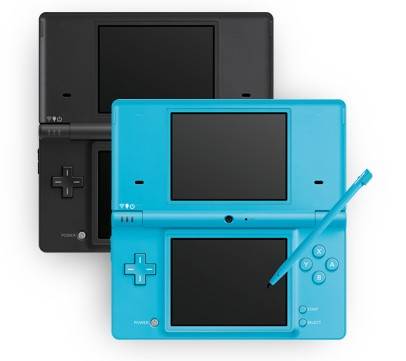 The latest in a long line of Nintendo’s repackaged, portable hardware, the Nintendo DSi ($169.99) launched last month and promptly sold 435,000 units in its first week. But while demand remains high, many gamers are still wondering if the extra RAM, built-in cameras, and most significantly, downloadable applications, warrant the higher price tag. It all depends on how willing you are to wait.
The latest in a long line of Nintendo’s repackaged, portable hardware, the Nintendo DSi ($169.99) launched last month and promptly sold 435,000 units in its first week. But while demand remains high, many gamers are still wondering if the extra RAM, built-in cameras, and most significantly, downloadable applications, warrant the higher price tag. It all depends on how willing you are to wait.
When its predecessor, the Nintendo DS Lite, launched in the summer of ’06 it was a significant upgrade over the original model, offering better backlighting, longer battery life, and a sleeker exterior. Comparatively, the aesthetic differences between the Lite and DSi are mostly negligible. The DSi sports slightly bigger screens and ditches the glossy finish, but the button layout and general feel are the same.
The DSi also lacks backwards compatibility with old Game Boy Advance games. This is admittedly a bummer, particularly for the handful of gamers who still partake in occasional Guitar Hero: On Tour jam sessions. However, for people who want to upgrade but don’t want to part with their older library, a used Advance SP would be an inexpensive fallback for most games.
Presumably, the Game Boy slot was left out to keep manufacturing costs down, but Nintendo would have been wiser to nix the camera and audio playback features first. At some point, developers will begin utilizing the camera in actual games, but at the moment it is little more than a diversion. The software is just too limited. Even 1998’s Game Boy Camera featured basic animation tools and games.
Ultimately though, the quality of the DSi shop software will determine whether the new system is a worthy follow-up. Downloadable console games have become an industry staple in recent years, and last year iPhone games skyrocketed in popularity. Considering how Nintendo has aped Apple’s style with both the Wii and the DS Lite, it seems natural that they would follow suit with the DSi. Unfortunately, the initial lineup doesn’t do much to instill confidence in the store.
 There are a few standout titles exclusive to the DSi that are currently available for download. The best of the bunch is easily Art Style: Aquia (pictured), an underwater themed tile puzzler with a hypnotic soundtrack and just enough depth to justify the $5 cost. Nintendo has also packaged stripped down versions of games like Dr. Mario and Brain Age. They’re affordable, but you’ve likely seen enough of these games by now.
There are a few standout titles exclusive to the DSi that are currently available for download. The best of the bunch is easily Art Style: Aquia (pictured), an underwater themed tile puzzler with a hypnotic soundtrack and just enough depth to justify the $5 cost. Nintendo has also packaged stripped down versions of games like Dr. Mario and Brain Age. They’re affordable, but you’ve likely seen enough of these games by now.
Most of the other titles are $2 diversions mined from older games, such as WarioWare, Inc. Nintendo even had the gall to release an Animal Crossing clock program, despite the fact that the system already includes one.
Only one game, WarioWare: Snapped, uses the camera in a meaningful way. It prompts players to pose in front of the screen to perform random tasks, such as watering plants, grabbing coins, and scaring babies; but temperamental motion sensing and a five minute length keep it from being something special. Still, it’s the only game that gives a glimpse of the DSi’s potential, so it’s not the worst way to spend the free points included in the box.
And in the end, that’s what you would be buying with the Nintendo DSi — potential. Nintendo has been slow to move toward online software, as anyone who frequents the WiiWare shop can tell you. But even if Nintendo fails to capitalize on the opportunity, plenty of third parties could conceivably fill in the gaps. It will just require some patience.








